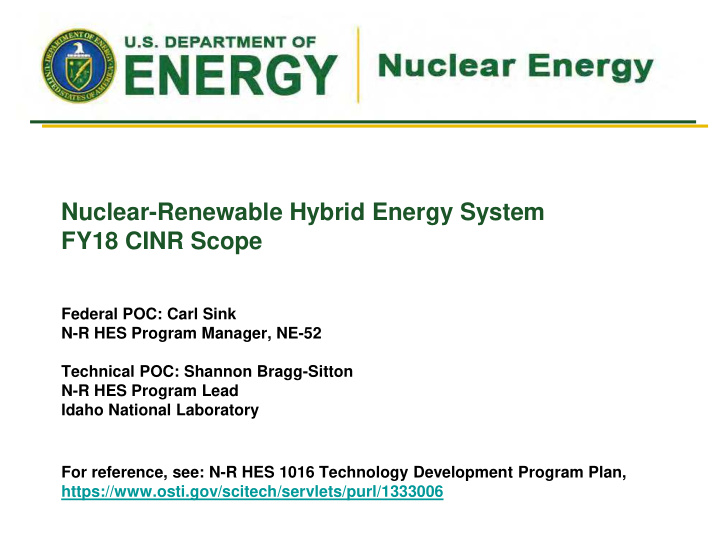



Nuclear-Renewable Hybrid Energy System FY18 CINR Scope Federal POC: Carl Sink N-R HES Program Manager, NE-52 Technical POC: Shannon Bragg-Sitton N-R HES Program Lead Idaho National Laboratory For reference, see: N-R HES 1016 Technology Development Program Plan, https://www.osti.gov/scitech/servlets/purl/1333006
N-R HES Program Overview N-R HES are Intermittent renewables cooperatively- controlled systems penetration can be that dynamically apportion thermal effectively managed and/or electrical energy to provide Wind Farm Replace responsive generation to the Clean heat dynamically Wind Farm peaking maneuvered for industrial power grid reserve with Wind Farm use and p ower generation hybridized Anticipated benefits include: baseload • Dispatchable, flexible electricity Thermal Energy Power Generation Power Generation provided to the grid Generation Grid • Synchronous electromechanical Thermal Electricity Energy inertia for the grid • Reduced industrial sector carbon Low Grade Thermal footprint GW-hr Battery Thermal or Energy Storage Mechanical Energy • Stabilized energy costs Storage Focused R&D in N-R HES design, O2 H2 Reduced energy Electrolysis Storage optimization, and testing for storage promising hybrid system requirements architectures, coupled with Consumer Products Natural development of technology Resources Intermediate H 2 and (Gas, Oil, Coal, Biomss Ore) options, will enable more efficient, Conversion Plant other Fuels environmentally sustainable chemicals/products energy systems produced 2
Expected Outcomes from NEUP Collaborations Engagement of university researchers having diverse expertise will bring new solutions to HES design, optimization and demonstration NEUP modeling and simulation scope is intended to develop tools and techniques that can solve longer-term questions associated with hybrid energy systems design, design optimization, and operational optimization • Analysis/evaluation approaches must be compatible with the laboratory developed toolset (RAVEN, Modelica) to allow for future integration • Deliverables should include modeling and simulation components that are ready for integration into the overall HES model architecture • Key contribution areas support longer-term needs, but could be integrated with the broader laboratory toolset as soon as they are available Scope related to technology feasibility will provide early demonstration of low TRL technologies that could improve the technical and/or economic performance of N-R HES • Proposed scope targets areas that are currently in the conceptual stage and must be demonstrated at the bench scale prior to integration with an HES • May include both bench-scale experiments and corresponding model development 3
N-R HES Modeling & Simulation The N-R HES program is seeking contributions that will result in development of additional modeling and simulation tools and approaches to support the development of advanced nuclear- renewable hybrid energy systems. Tools must be able to link with Modelica component models and RAVEN optimization tools under development by the DOE national laboratory team. Proposals are sought in the following areas: • Development of additional detailed component models to support integrated system evaluation within the HES modeling and simulation framework and within specific regions. Could include energy storage systems, industrial processes, etc., translating mathematical models into compatible Modelica models. • Evaluation of the economic potential and advantage of new process design with heat storage over baseload electricity production. • Characterization of dynamic energy system behavior to determine impact of thermal cycling of components and subsystems on component and system robustness, resiliency, response rates, etc. 4
Support for N-R HES System Demonstration The N-R HES program is interested in demonstrating low TRL system components and/or subsystems at reduced scale to show technical feasibility, economic potential of integration, etc. Proposals are requested in the following areas: • Scaled studies of energy storage concepts, e.g. a scaled down demonstration of thermal energy storage concepts that could later be integrated in the INL Dynamic Energy Transport And Integration Laboratory (DETAIL) for integrated systems testing. • Efficient temperature amplification technologies, such as chemical heat pumps, that can allow conventional LWRs and near term SMRs to support a wider range of industrial applications. Options could include upgrading of “waste heat” or primary heat from the systems. Concepts should give consideration to operational, regulatory, and safety constraints associated with an operating nuclear plant. 5
More recommend